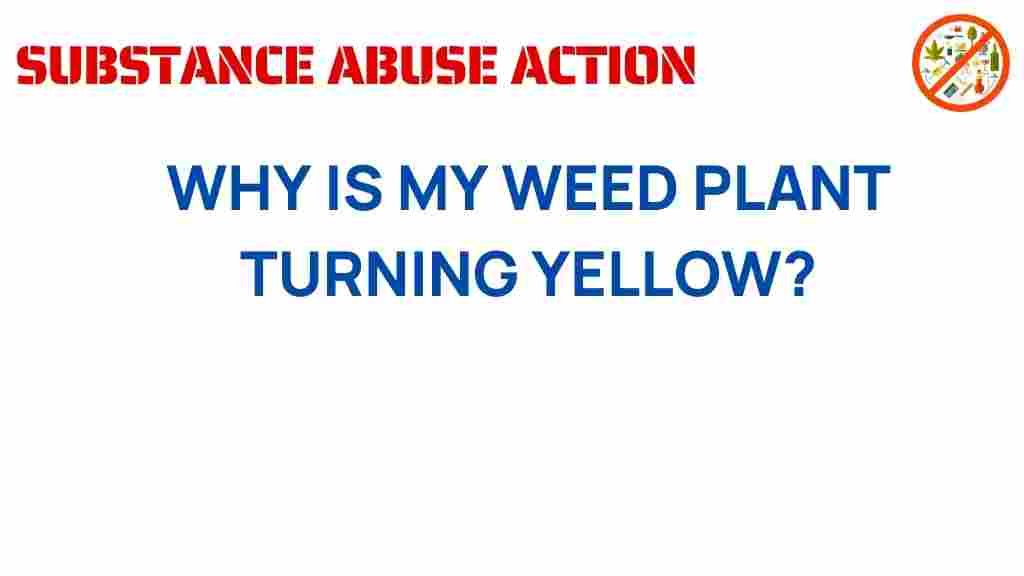Unraveling the Mystery: Why Is My Weed Plant Turning Yellow?
As a cannabis enthusiast or grower, encountering yellow leaves on your weed plant can be alarming. Yellowing leaves can indicate various issues, from nutrient deficiencies to environmental stress. Understanding the causes and solutions of this common problem is essential for maintaining plant health and ensuring a successful harvest. In this article, we will explore the reasons why your weed plant is turning yellow, how to troubleshoot these issues, and provide valuable cannabis care tips to keep your plants thriving.
Understanding Yellow Leaves in Your Weed Plant
Yellow leaves on a weed plant can result from several factors. It is crucial to identify the underlying cause to implement the right solutions. Here are some common reasons for yellowing leaves:
- Nutrient Deficiencies: A lack of essential nutrients can lead to yellow leaves.
- Overwatering: Excess water can suffocate roots and lead to yellowing.
- Pest Infestations: Pests can stress the plant, causing leaves to turn yellow.
- Environmental Stress: Factors like temperature and light can affect plant health.
Nutrient Deficiencies
Nutrient deficiencies are a common issue that can cause your weed plant’s leaves to turn yellow. Here are some key nutrients that, when lacking, can affect your plant:
- Nitrogen: A nitrogen deficiency often results in older leaves turning yellow, starting from the tips and moving inward.
- Iron: An iron deficiency typically causes young leaves to yellow while the veins remain green, a condition known as interveinal chlorosis.
- Magnesium: Magnesium deficiency often leads to yellowing between the veins of older leaves.
Overwatering
Overwatering is another common issue that can lead to yellow leaves. When a weed plant receives too much water, the roots can become waterlogged, leading to root rot. Symptoms include:
- Leaves turning yellow or wilting
- Soft, mushy stems
- Foul smell from the soil
Pest Infestations
Pests can wreak havoc on your weed plant, causing stress and yellowing. Common pests that may lead to yellow leaves include:
- Spider mites: These tiny pests can cause stippling and yellowing of leaves.
- Thrips: Thrips can lead to overall yellowing and leaf drop.
- Aphids: These sap-sucking insects can cause yellowing and curling of leaves.
Environmental Stress
Factors such as temperature, humidity, and light can affect your weed plant’s health. High temperatures can stress plants, while low humidity can lead to nutrient uptake issues. Additionally, inadequate light can result in poor growth and yellowing leaves.
Step-by-Step Process for Troubleshooting Yellow Leaves
If you notice yellow leaves on your weed plant, follow these steps to diagnose and address the issue:
1. Assess Your Growing Environment
Start by checking the environmental conditions of your grow space. Ensure that:
- The temperature is within the ideal range (70-85°F during the day and slightly cooler at night).
- The humidity levels are appropriate for the growth stage (40-60% during vegetative growth, lower during flowering).
- Your plants receive adequate light (12-18 hours for vegetative growth, 12 hours for flowering).
2. Check for Pests
Inspect your plants for signs of pests. Look for:
- Webbing or spots on leaves (indicating spider mites).
- Discolored or sticky leaves (indicating aphids or thrips).
If you find pests, consider using organic insecticides or introducing beneficial insects to control the infestation.
3. Evaluate Watering Practices
Review your watering schedule. Overwatering is a common issue, so ensure that:
- You allow the top inch of soil to dry out before watering again.
- The pots have proper drainage to prevent water accumulation.
4. Test for Nutrient Deficiencies
Check your feeding regimen to determine if your weed plant is receiving the right nutrients. If you suspect a deficiency:
- Consider using a balanced fertilizer that includes nitrogen, phosphorus, and potassium.
- For specific deficiencies, incorporate supplements like iron chelate or magnesium sulfate.
5. Monitor and Adjust
After making adjustments, monitor your weed plant for improvement. Look for:
- New growth that is healthy and green.
- Signs of recovery, such as leaves perking up or returning to their original color.
Gardening Tips for Healthy Cannabis Cultivation
Maintaining the health of your weed plant is vital for a successful grow. Here are some essential cannabis care tips:
- Choose Quality Soil: Start with high-quality soil that contains the right nutrients and has good drainage.
- Proper Lighting: Ensure your plants receive adequate light according to their growth stage.
- Regular Feeding: Follow a feeding schedule tailored to your plant’s needs, adjusting based on growth and symptoms.
- Monitor pH Levels: Keep the soil pH between 6.0 and 7.0 to ensure nutrient availability.
- Practice Good Hygiene: Keep your grow area clean to prevent pests and diseases.
Preventive Measures
To prevent yellow leaves in the future, consider these tips:
- Conduct regular health checks on your plants.
- Implement a consistent watering and feeding schedule.
- Keep an eye on environmental conditions and adjust as needed.
Conclusion
Yellow leaves on a weed plant can signal a range of issues that require prompt attention. By understanding the causes of yellowing leaves—such as nutrient deficiencies, overwatering, pest infestations, and environmental stress—you can take the necessary steps to troubleshoot and restore your plant’s health. With proper cannabis care, including monitoring growing conditions and practicing good cultivation techniques, you can prevent future growth issues and enjoy a bountiful harvest.
If you want to learn more about cannabis cultivation and plant health, check out this comprehensive guide for further insights and expert advice.
For more information on pest control and gardening tips, visit this resource to enhance your cannabis growing experience.
This article is in the category Health and created by SubstanceAbuseAction Team

1 thought on “Unraveling the Mystery: Why Is My Weed Plant Turning Yellow?”